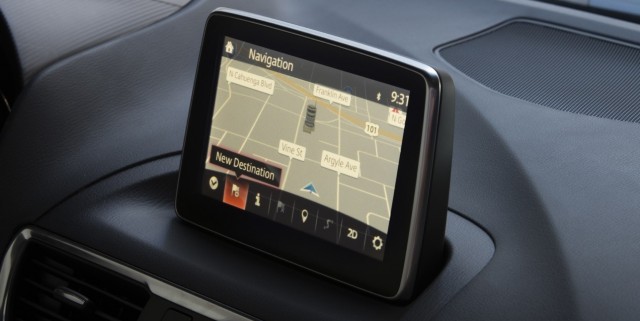
The new infotainment system in the 2014 Mazda 3 aims to future-proof the car to keep up with the ever-changing world of multimedia and smartphones while providing a safer and less distracting cabin environment.
At the launch of the new Mazda 3 in Los Angeles, the company’s general manager of production division, Ryuichi Umeshita, explained in detail the work that had gone into the car’s infotainment system.
Mazda has spent considerable effort designing a cabin that reduces driver distraction behind the wheel. Everything from the angle of information displays to text size has been analysed over and over to ensure a safe cabin environment.
The three modes of distraction – visual distraction (eyes off road), cognitive distraction (wandering mind) and manual distraction (hands off wheel) – were key targets for Mazda’s human machine interface (HMI) designers.
Umeshita said Mazda used American psychologist George Miller’s research into how many pieces of information an average adult can recognise at once (seven plus or minus two) to come up with the Mazda 3’s display interface, which sits 750mm away from the driver’s eyes.
With this equation in mind and the ISO standards for text size and line spacing, which Mazda improved on, a seven-inch high-resolution display was chosen.
The screen, although touch-sensitive, is locked to a rotary dial and voice interface when the vehicle is moving, as Mazda’s research showed a vehicle is far more likely to move around unintentionally when the driver is distracted with a touchscreen compared with a rotary dial or voice input.
The other feature added tohigh-endMazda 3 models is the head-up display, which projects the car’s speed, navigation instructions and safety warnings in front of the driver.
As for future-proofing, Umeshita admitted Mazda had little idea where smartphone and multimedia technology was headed, so decided it was best to make it as updatable as possible.
“In this new connectivity system we have two strong points. The first one is what we call modular hardware and updatable software, the second one is coverage of the smartphone application,” Umeshita said.
“Until 25 or 30 years ago I have been listening to records, right after that I began to use the CD, meanwhile cassette tape recording is gone from my house and now we are using iPhone or iPods and in five or 10 years from now I have no idea what kind of things we would use.”
He said it was the first point of discussion within Mazda when designing the new 3’s interface.
“If you buy a car with a cutting edge connectivity system it may become outdated in five years, we don’t know. We wanted to avoid that situation as much as possible so we designed the hardware to be very flexible. We can attach many kinds of hardware afterwards.
“Also, software is updatable, just like smartphones, through USB ports, [the] whole software can be rewritten”.
This means that when system’s like Apple’s iOS In The Car become mainstream, Mazda can potentially reprogram its infotainment system to interact with the new features, instead of leaving it to become obsolete.
Music lovers will also be pleased as Mazda has teamed up with Aha and Pandora to bring internet radio to the 3. Aha also allows integration with Facebook and Twitter when the app is downloaded to a smartphone and synced to the Mazda 3’s system.
The third-generation Mazda 3 launches in Australia in late January.





